Articles
Articles are a shared content type. You can use articles for time-sensitive content like news, press releases. or blog posts.
Title:
This is the title of the article. It will determine the URL (unless you manually change the URL path setting) and will display in large font at the top of the page.
Feature Checkboxes:

- Feature article on news landing page: the article will display in the slideshow at the top of the news landing page if the 'news slideshow' option is chosen
- Feature article on home page: the article will display in the slideshow at the top of the home page if the 'news slideshow' option is chosen
Video:
If this section is used, it will display in the header area instead of an image or solid color background. The YouTube video browser URL should be used in the Video URL field.
Header Image:
The header image is a full-width image that displays in the header area behind the title, date, author, and taxonomy terms. The minimum size for this image is 1366 x 548 pixels, but we suggest using an image that is larger than the minimum. Header images will also be displayed in the home page and article landing page header slideshows. For more detailed information about images, please consult our image guide.
Link Thumbnail:
The article thumbnail image displays in many places, including the Card layout of the news landing page and sections of the home page and multipurpose pages that pull in articles. Because they display in so many places, we highly recommend using a thumbnail image with all of your articles. The minimum size for a thumbnail image is 600 x 600, but we suggest using an image that is larger than the minimum. For more detailed information about images, please consult our image guide.
Reverse Header Checkbox:
If you are not using a header image, this option allows you to change the background color of the header area from the default to its opposite
Author Name:
The name of the person who wrote the article. The name will appear in the header of the article.
Direct Link:
Use this field to paste in the URL of an article that you are including from an external website or a Washington University site that does not participate in our content-sharing. For example, if you wanted to add an article from the New York Times on your News landing page, you would put the URL of the article here.
Name of Publication:
This field should be used to enter the name of the publication you are linking to in the direct link field.
Teaser Text:
The teaser text does not display on the individual article. Instead, the teaser text appears on the News landing page when you are using the List layout style. Please keep it under 120 characters. If you are using the "Direct Link" to link to an outside website, this is a good place to indicate to the reader where the article resides. For example: "John Doe discusses his latest work in The New York Times."
Intro Text:
Text in this field will display at the top of the article in large italics font for visual impact.
Body:
This section is for the main body of the article. You can use the WYSIWYG toolbar to add text, lists, images, video, links, etc.
Category:
This is a list of all of the available taxonomy terms for Articles. Tagging your articles with taxonomy terms allows them to be sorted by categories on your News landing page.
Display this article on these profiles:
Use this field to link the article to any faculty or staff with whom it is associated. Start typing the name of the person and the field will start to autofill. If you need to add multiple names, insert a comma and then start typing the next name. The article will appear in the lower section of the person's profile page if the profile is set to "Long."
SoundCloud:
This field allows an audio file to be embedded at the top of the article. The file must first be uploaded to SoundCloud (a site similar to YouTube for audio).
Footer Callout:
When creating an article, you have the option of adding a callout box just above the footer. This can be used to create a call to action for the visitor, such as "sign up for our newsletter" or "donate" or it can be used to direct visitors to other content that may be of interest.
Search:
Adding a word to this field will affect the internal site search results. If a word is entered into that field, regardless of whether it is in the content of that page, the internal site search will place a higher weight on that page when someone searches for that word.
For example, when searching the term "Psychology" without adding that word to the search box of any pages, the returned search results will put "Philosophy-Neurosciences-Psychology" at the top of the results because the word "Psychology" is in its title. It would put the page title "Psychological and Brain Sciences" further down the list because "Psychology is not in the title (though it is used in the body of the page). Adding that term to the "Psychological and Brain Sciences" page causes it to be higher in the search results when a visitor searches for the word "Psychology."
Shared Content Toggle
If you would like to make this piece of content available for other sites to import, turn on the shared content toggle. This will also open a field letting you notify other departments who may be interested in importing your content.
To link to an article located in an external website or a Washington University site that does not participate in content-sharing, copy/paste the URL of the article into the Direct Link field. For example, if you wanted to add an article from the New York Times to your News landing page, you would do the following:
- Go to 'add content' and add a new article.
- Add a title, thumbnail image, and teaser text.
- Put the URL to the external article into the direct link field.
- You can also optionally add the name of the publication you are linking to in the direct link field.
- If the article is not in the current site, you can toggle on the 'link goes outside of current site' toggle.
- Save the article
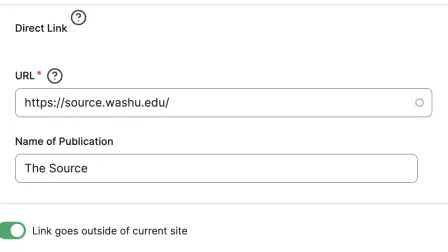
The Soundcloud field allows an audio file to be embedded at the top of the article. The file must first be uploaded to SoundCloud (a site similar to YouTube for audio).
To add a podcast to the Soundcloud section of an article, click the 'add podcast' button. When you do so, you will get a popup window giving you the option to choose any existing Soundcloud URL in your website.

If you would like to add a new podcast URL, click the Add Soundcloud URL tab and follow the directions to enter a Soundcloud browser URL.
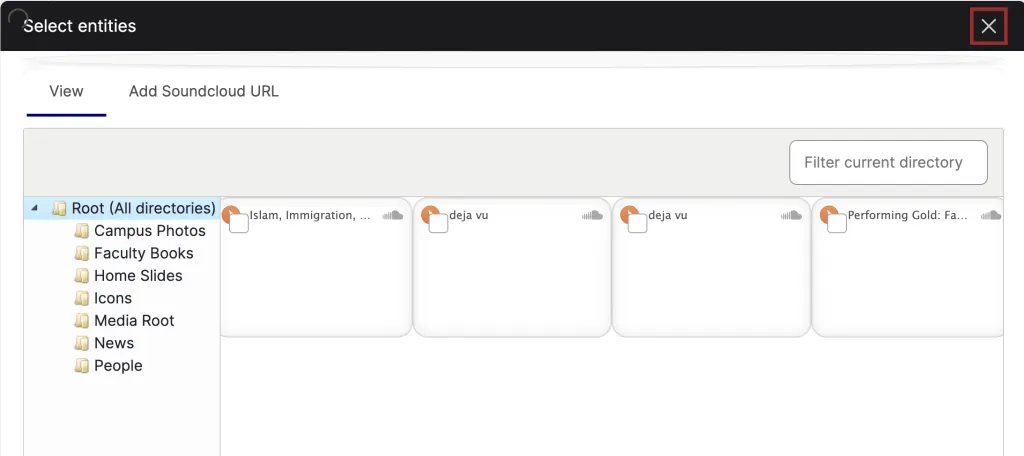
By default, comments will be turned off for all new content.
You can open comments on any individual article. This will allow visitors to comment on that particular article. To disable comments on an article, go to the edit form for that article, click on "comment settings" in the vertical tabs to the right, and select "Closed."
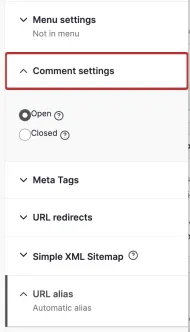
To approve comments made on your site, you may browse to the article containing unapproved comments and click "approve" or you may approve comments in bulk on the comment administration page. To view a full list of unapproved comments and approve or delete them, click "content" in the admin bar, click the "comments" tab, and then click "unapproved comments" at the top of the page.
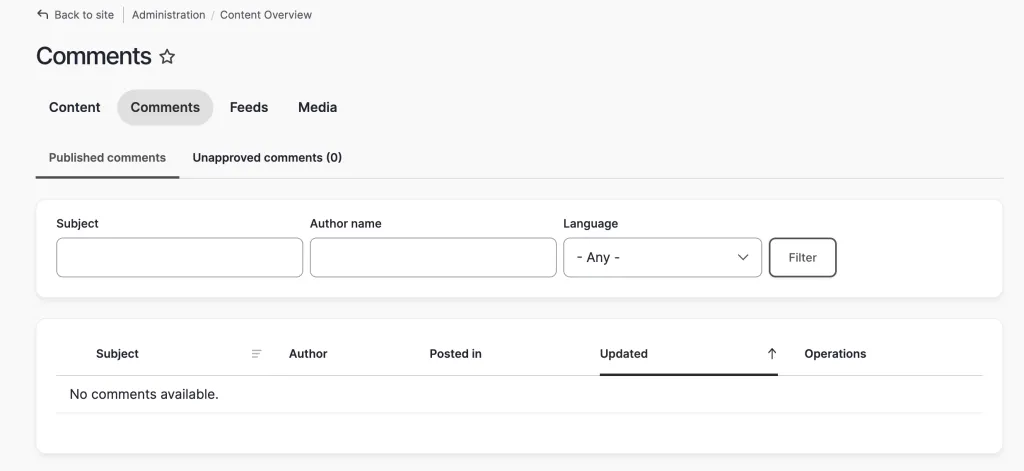
Article Examples
This example shows an article with a header image, footer section, and a podcast. The auto-populating 'In the News' section displays the most recent articles on the site.

This example shows an article using a video header instead of an image or solid background.

News Landing Page
The News landing page is a list of all of the published articles in your website. All published articles will automatically appear on the Article landing page.
The News landing page has two options for the header.
Static Image:
If you choose the static image option, a single image will always display in the header section along with the landing page title.

Featured News Slideshow:
In the slideshow option, the header will display as a slideshow featuring individual articles that have their 'feature on news landing page' box checked. If you decide to use this option, you will need to make sure that your featured articles have a header image. To remove an article from the header slideshow, uncheck the 'feature on news landing page' box on the event. If an external article is featured, you have the option of displaying the name of the publication that the article appears in.
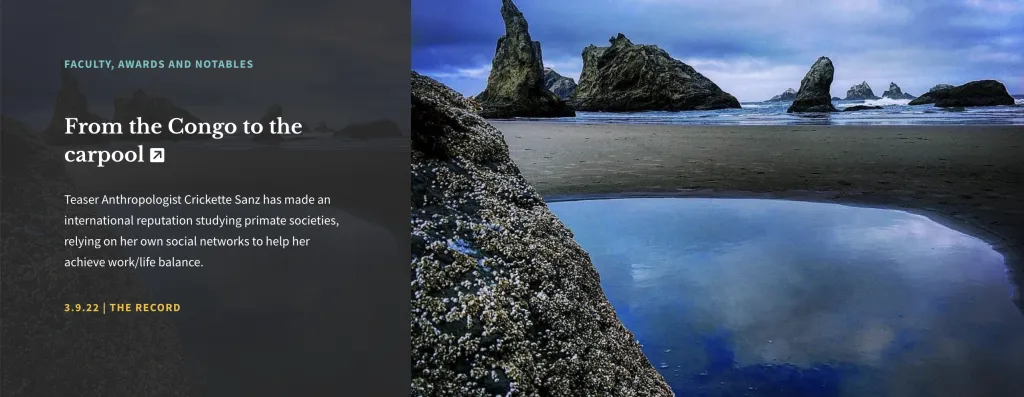
The footer section is at the very bottom of the News landing page and displays text and an optional button. You can also add social media links, an ampersand icon, and have a white or grey background. This is a great place to link a newsletter or an action item for a user.

The News landing page can be set to display as a list (text) or as cards (images). If you would like to change your layout, you can contact the web team at artsci-webteam@wustl.edu
Card Layout:
If you select the Card layout, it is important for your articles to have thumbnail images. Without a thumbnail, the default ampersand image will display. This looks fine occasionally interspersed with other images but does not look very nice when there are a lot of them.
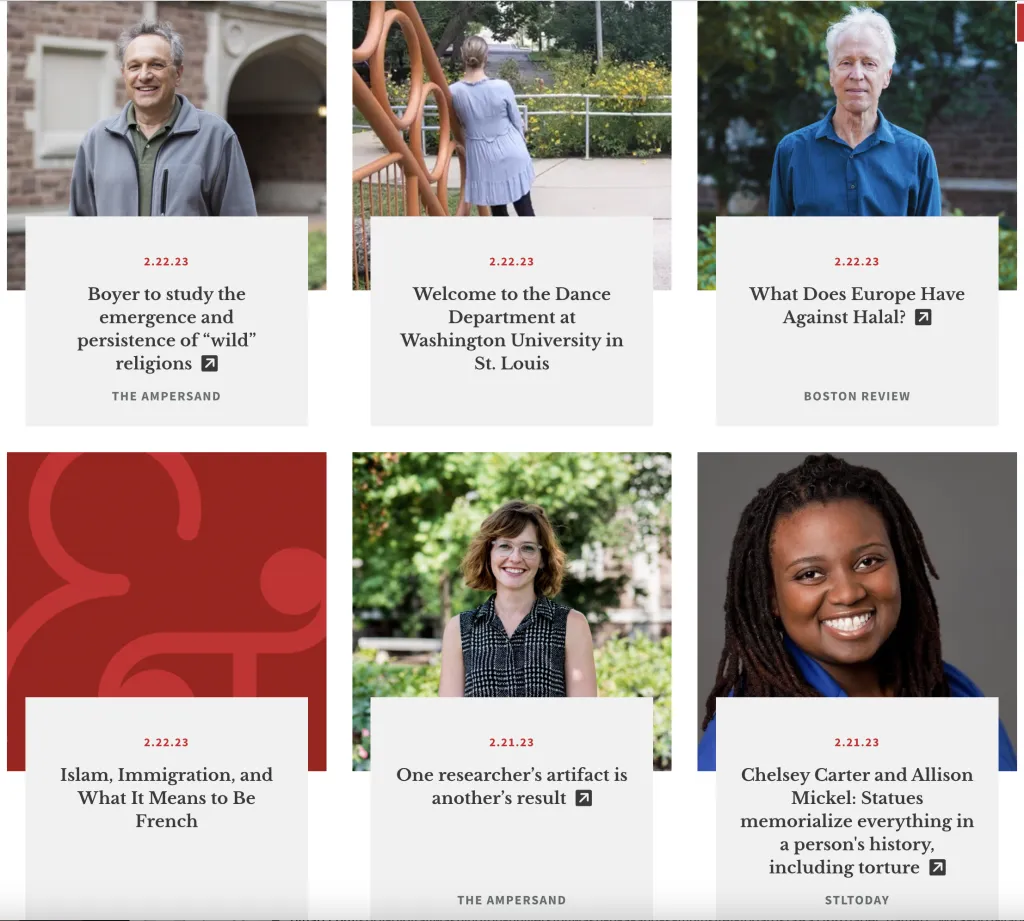
List Layout:
If you select the List layout, it is important that your articles use text in the "Teaser text" field because there is a space for it to display and the landing page looks empty and unbalanced without it. Even though this layout doesn't display a thumbnail image, you will still need to add one in case your event is shared with a department that uses the Card layout.

The taxonomy terms on your News landing page are located under the search bar and are used to sort your articles by category. You can tag a piece of content with multiple taxonomy terms. If you do not tag a piece of content, the content will still display on the landing page, but will not display if a user clicks on taxonomy terms since it hasn't been tagged with anything.
You have three options for displaying your taxonomy terms:
Always open:
The taxonomy terms will always be visible.

Collapsed:
The taxonomy terms will be hidden and the user can click on the 'V' to make them visible.

Hidden:
There will be no taxonomy terms visible to the site visitor, only the search bar. However, they will still be available when you are editing the article and would like to tag it with a taxonomy term.
The 'all' taxonomy term will always display in the list of categories and cannot be removed. Any changes that need to be made to the article taxonomy/filter terms or how they display can be sent to the web team at artsci-webteam@wustl.edu
Articles can display in many different sections on your website including:
- All published articles will automatically appear on the news landing page.
- In the Featured News header slideshow option on the home page or news landing page.
- Any section in the home or multipurpose pages that allows you to pull in articles.
- In the auto-populating In the News section located at the bottom of a long person profile and at the bottom of a news article.
- Articles getting pulled into a Publication page.
- If your article is shared, then it can appear in all of these places not only on your site but other department sites.
If you feature an article on your news landing page or home page or if you are making the article sharable, be sure to include a header image and a link thumbnail image and teaser text. Depending on where you or other departments feature the content, these images will display.
Tips and Tricks to Successful Articles
- Header and Thumbnail images should never include text. Search engines and website visitors who use screen readers can’t access the text.
- Please note that not every article needs a header image! Sometimes it is hard to find a large enough image for this area or one that looks correct, and in those cases it is absolutely fine to leave this area empty. Without a header image, a background color (light or dark) will display behind the article title instead.
- Before you attempt to alter any of your photos, it's important to understand the difference between resizing and cropping. Please consult our Resizing Images for the Web guide for resources and guidance.
- Headshots almost never work as header images because the title text obscures the person's face. You always have the option to embed smaller images in the body text instead.
- For help finding large, license-free images that may work as header images, see our Image Guide.
- The article title should be unique to that piece of content. You should not have multiple articles with the same name.
- Do not use all caps in your title.
- Capitalize the first word in your title and proper nouns. Do not capitalize every word in the title. This follows Public Affairs style and makes news appear more consistent across platforms.
- If the article is part of a specific category of news within your department, such as faculty profile, alumni spotlight, announcement, the category name should not appear in the title.
- Set up these news-series types as categories and tag articles on the back end of your website.
- For example, don't use "Department Colloquium: Black Holes in the Universe" as an article title.
- Use specifics in your title.
- “Anthropology alumna wins 2019 Best Thesis Award” rather than “Alumna wins award.”
- If sharing to the main ArtSci or other sites, consider how the title will read outside of the context of your website.
- Use faculty’s first and last name in title.
- “John Doe wins Guggenheim Award” rather than “Prof. Doe wins Guggenheim Award.”
- “John Doe wins Guggenheim Award” rather than “Prof. Doe wins Guggenheim Award.”
- Do not include date in the title. The date will appear elsewhere.
- Use this area to provide a brief summary of the article, to let readers know what to expect. For example:
- "Six Arts & Sciences students shared how they found and fell in love with their chosen areas of study."
- "Even the hardest plant tissues scarcely wear down primate teeth, according to a new experimental study from anthropologists in Arts & Sciences."
- "In an era of worries over fake news, who can be trusted? Taylor Carlson studies the effects of interpersonal political communication, especially on social media."
- Use full sentences, rather than simply listing a name or other item.
- Keeping intro text to just one or two sentences to grab the reader's attention.
- Often, the same blurb can be used as both intro text and teaser text.
If your article looks strange but you can't figure out why, it is often because there is some extra formatting copy/pasted in with the text. One of the most important and underused buttons in the toolbar is the clear formatting button:
If you are pasting in text from a Word document or elsewhere, always select all the text and then this button. This allows the font to display correctly.